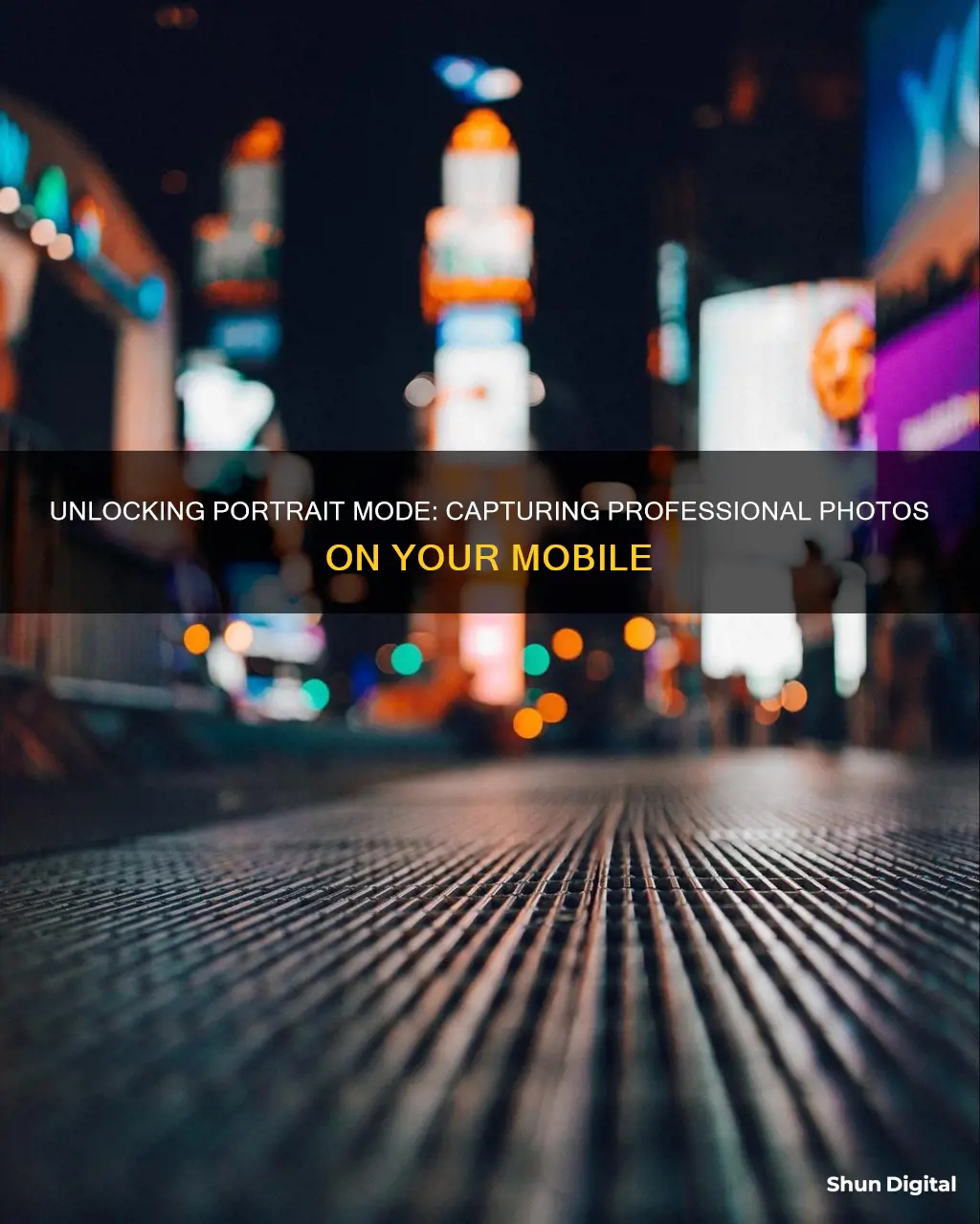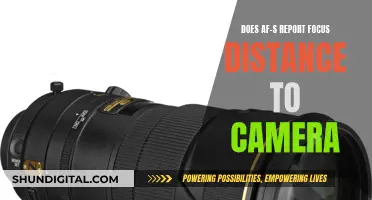
Portrait mode is a setting in smartphone cameras that creates a shallow depth of field, blurring the background of a photo and keeping the subject in focus. This effect is known as 'bokeh' and is commonly associated with photos taken on DSLR or mirrorless cameras with specialised lenses, larger sensors, and high focal lengths. Portrait mode was popularised by Apple in 2016 with the release of the iPhone 7 Plus, and has since become a common feature on most smartphones.
| Characteristics | Values |
|---|---|
| Purpose | To take better pictures of people by capturing a sharp face and a nicely blurred background |
| Use | Can be used for objects as well as people |
| History | Started as one of the scene modes on a digital camera, but has since been adapted for smartphone photography |
| Function | Artificially applies blur to the background |
| Implementation | Differs between manufacturers, but often uses a combination of hardware and software |
| Hardware | Dual-lens camera, depth sensors, ToF sensors |
| Software | Computational photography, AI, facial recognition |
| Results | Can vary due to different software and algorithms used; the best results come from phones with ToF sensors |
| Improvements | Some manufacturers add extra improvements such as skin smoothing, increasing shadows, and reducing highlights |
| Availability | Widely available on modern smartphones, including Samsung, Apple, Google, and Nokia devices |
| Options | Different blur intensities, portrait lighting effects, and video mode |
| Third-party apps | PicsArt, AfterFocus, LightX, AirBrush |
What You'll Learn

Portrait mode replicates the bokeh effect of DSLR cameras
Portrait mode is a setting in smartphone cameras that blurs the background of an image, keeping the foreground in focus. This replicates the bokeh effect often seen in photos taken on DSLR cameras. Bokeh is a Japanese word that translates to "blur" and is used to describe how a camera lens renders a background that is out of focus.
DSLR cameras are larger than smartphones and have bigger sensors and variable apertures, which create a shallow depth of field and a prominent blur effect in the background. Smartphone cameras, on the other hand, have tiny sensors and comparatively wider apertures, making it difficult to achieve this level of bokeh without being very close to the subject.
To replicate the bokeh effect of DSLR cameras, smartphone manufacturers introduced portrait mode, which uses a secondary camera sensor or software algorithms to differentiate between the background and the subject. This allows the camera to apply a blur effect to the background while keeping the subject in focus, mimicking the look of a professional DSLR camera.
Portrait mode has become a standard feature on most smartphones, and with advancements in camera technology, the results are constantly improving. While there may still be some imperfections, the algorithms responsible for portrait mode are continuously being refined, making it easier for anyone to capture professional-looking photos with their smartphone.
By utilising portrait mode, smartphone users can achieve similar visual effects to those produced by DSLR cameras, blurring the background and drawing attention to the subject. This effect is particularly useful for portrait photography, as it ensures the person remains the focal point of the image, while any distractions in the background are muted.
Raw Files: Unlocking the Power of Photography
You may want to see also

It artificially blurs the background
Portrait mode is a setting in smartphone cameras that artificially blurs the background of an image, mimicking the bokeh effect often seen in photos taken with DSLR or mirrorless cameras. This effect is achieved through a combination of hardware and software solutions, depending on the smartphone model. The background blur draws the viewer's attention to the subject, typically a person, and can help create a professional-looking image.
The bokeh effect in portrait mode is achieved by differentiating between the background and the foreground or subject of the image. Smartphone cameras, often with the help of a secondary camera sensor, detect the edges of the subject and keep that in focus while blurring the background. This differentiation is done through various methods, including edge detection, depth information, and semantic segmentation. The device then uses a series of cameras and sensors to determine the distance between objects in the frame and applies the blur effect during post-processing.
The artificial blurring of the background in portrait mode aims to replicate the shallow depth of field achieved with larger sensors and variable apertures in dedicated DSLR or mirrorless cameras. By blurring the background, portrait mode creates a pleasing look that reduces distractions and emphasises the subject. This effect is particularly popular for portraits, as it ensures the person being photographed stands out while minimising the impact of the background.
While the bokeh effect is the most notable feature of portrait mode, smartphone manufacturers often include additional improvements. These enhancements can include skin-smoothing, increasing shadows, reducing highlights, and enhancing specific colours, such as reds and pinks on lips. These added adjustments further enhance the overall appearance of the image and contribute to a more professional-looking photograph.
The artificial background blur in portrait mode is a result of the limitations of smartphone camera hardware. Due to the small sensors and wide apertures in smartphone cameras, achieving a natural blur effect is challenging unless the subject is very close. Portrait mode addresses this limitation by artificially adding the blur effect during post-processing, allowing for more aesthetically pleasing photographs with a sharp focus on the subject.
Camera Modes in League of Legends: What's the Difference?
You may want to see also

It works best for close-up photos of people
Portrait mode is a feature on many smartphones that helps you take better pictures of people by capturing a sharp image of the foreground subject and blurring the background. It is designed to improve close-up photos of one person, which is why it is called portrait mode.
Portrait mode was initially a feature of digital cameras that helped novice photographers take better portraits by adjusting the camera settings. On a smartphone, portrait mode artificially applies blur to the background to mimic the background blur of a DSLR camera.
Portrait mode works best for close-up photos of people because it allows you to focus on the person's face or upper body while blurring the background. This gives the image a nice look as the complete focus is on the subject, and the background is not distracting.
Smartphone cameras typically have tiny sensors and comparatively wider apertures, which makes it difficult to achieve a blurred background unless you are very close to the subject. With portrait mode, you can take a portrait photo from a more comfortable distance while still achieving the desired blur effect.
Additionally, portrait mode on smartphones often includes added improvements specifically for photographing people. For example, it may smooth the skin, increase shadows, reduce highlights, or enhance certain colours, such as reds and pinks on lips.
Portrait mode is a great tool for taking professional-looking photos of people with your smartphone, creating a similar effect to that of a DSLR camera.
Candid Camera Mode: Capturing Unscripted Moments
You may want to see also

It can be achieved with a dual-lens camera or software
Portrait mode is a setting in smartphone cameras that blurs the background of an image, mimicking the bokeh effect of a DSLR or mirrorless camera. This is achieved by simulating a shallow depth of field, which can be done with a dual-lens camera or software.
Dual-Lens Camera
Smartphone cameras with two lenses can use depth mapping to differentiate between the foreground and background of an image. The iPhone 7 Plus, for example, uses its wide-angle and telephoto lenses to create a depth map, artificially blurring objects depending on their distance from the subject in focus. This replicates the bokeh effect of a professional camera, where a wider aperture naturally creates a more prominent blur in the background.
Software
Portrait mode can also be achieved with software, using computational algorithms to detect and differentiate between the background and the subject. The Google Pixel 2, for example, uses pixel splitting to create a depth map, and machine learning to identify the subject and create a mask. This allows the phone to take portrait mode shots from the front-facing camera, as it doesn't rely on two distinct lenses.
Other smartphones, like the iPhone SE 3, use software algorithms to take portrait mode selfies, while some use a combination of a secondary camera and software, as seen in the iPhone 7 Plus.
Mastering Manual Mode in Photography: M Mode Explained
You may want to see also

It has different names on different phones
Portrait mode is a setting in smartphone cameras that blurs the background of a photo, mimicking the bokeh effect typically seen in DSLR or mirrorless cameras. This effect is achieved through a combination of hardware and software solutions, depending on the phone model and manufacturer. While the feature is commonly referred to as "Portrait Mode", it does go by different names on certain phones and operating systems.
On Apple iPhones, the feature is called "Portrait Mode", a name that was introduced with the release of iOS 10.1 in 2016. On Samsung Galaxy phones, the equivalent feature is called "Live Focus", which is available on newer models with One UI 4 and later software, such as the Galaxy S21, S22, S23, and S24 lineups. Older Samsung smartphones, such as the Galaxy S6 and S7, offered a similar effect called "Selective Focus", although it was less accurate and of poorer quality.
Huawei's P20 and P20 Pro flagships offer two bokeh effect modes: "Aperture", which is a general bokeh mode for blurred background photos, and "Portrait", which includes lighting, beauty, and bokeh filters. Nokia's high-end smartphones, such as the Nokia 8 and 9, feature a mode called "Live Bokeh", while the Xiaomi A1, part of the Android One program, automatically applies a "Depth Effect" when a subject is in focus in the foreground.
While the specific name and implementation may vary across different phone models and brands, the underlying principle of achieving a shallow depth of field and a blurred background remains consistent. This effect enhances portrait photography by keeping the subject in sharp focus while softly blurring the background, creating visually appealing images that mimic the results of professional camera equipment.
Charging the 808 Camera: Long First Charge Needed?
You may want to see also
Frequently asked questions
Portrait mode is a feature on smartphones that helps you take better pictures of people by capturing a sharp image of the face and blurring the background. It is designed to improve close-up photos of one person, but can also be used for objects.
Portrait mode artificially applies a blur effect to the background, mimicking the look of photos taken with a DSLR or mirrorless camera. This is achieved through a combination of hardware and software, with some phones using dual-lens depth mapping, pixel-splitting, or software-only portrait mode.
DSLR cameras have larger sensors and adjustable apertures, allowing for a natural blur effect when taking portraits. Smartphones, on the other hand, have smaller sensors and fixed apertures, so they use computational photography to artificially create the blur effect in portrait mode.
To enable portrait mode, open your camera app and look for the "Portrait" option. On some phones, this may be called "Live Focus", "Bokeh Mode", or "Lens Blur". If you can't find it, try swiping to the left or right, or checking the More section or three-dot menu.







